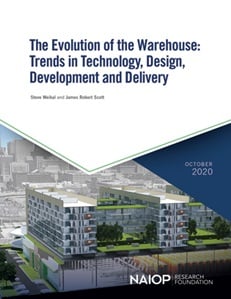The Future of the Warehouse Takes Shape

New technologies are accelerating the evolution of industrial real estate.
Rapid growth in e-commerce sales over the past decade has reshaped industrial real estate, creating demand for large distribution centers and smaller fulfillment centers located in urban and suburban areas. E-commerce supply chains require distribution and fulfillment centers to handle a larger number of items in smaller quantities than traditional retail or manufacturing supply chains, making them more labor- and capital-intensive. Retailers and third party logistics firms have responded to these increased demands by investing in automated systems and other logistics technologies to increase operational efficiency and productivity.
Advancements in these technologies are creating new possibilities in commercial real estate. The NAIOP Research Foundation has published a report titled “The Evolution of the Warehouse: Trends in Technology, Design, Development and Delivery,” by Steve Weikal and James Robert Scott, researchers at the MIT Real Estate Innovation Lab. Weikal and Scott reviewed recent publications on emerging logistics and building technologies and interviewed industry practitioners to evaluate how these technologies will influence the future of logistics real estate. Continued advances in automation, data analytics and artificial intelligence promise to make industrial assets more productive and profitable, create new opportunities in building design, and blur traditional boundaries between property types.
Evolution of Industrial Buildings
A range of automated technologies are improving throughput at distribution and fulfillment centers, and increasing their potential value. Automated storage and retrieval systems (ASRS) are increasingly common, and they can be tailored to fit in both large and small buildings. Collaborative mobile robots, once a novelty, are also being adopted by a range of industrial tenants, and they can be easily adapted to existing building layouts. Emerging technologies such as humanoid robots that can pick, move and lift items have reached a stage of development that they could soon appear alongside human workers.
These automation technologies can help industrial tenants store, retrieve, pick and pack goods more quickly and use vertical space more efficiently, making industrial buildings with higher clear heights or multiple stories more cost-effective. Automation can also improve worker safety and productivity by reducing the need for workers to perform repetitive motions or lift heavy objects. Although future technological advances might allow for fully automated facilities, Weikal and Scott do not expect that automation technologies will completely replace human workers in most facilities in the near future. Instead, these technologies will increasingly allow workers to focus on creative problem solving and other tasks that are not easily automated.
In addition to physical automation technologies, advances in data analytics and artificial intelligence are making supply chains more efficient and are helping developers, retailers and logistics firms make better locational decisions. Better data collection and analysis can allow end-users to optimize the allocation of inventories across industrial properties and can help developers predict which locations are best situated for distribution or fulfillment centers.
Blurring Traditional Boundaries in Land Use
ASRS systems that can be scaled up or down and tailored to a variety of different building formats also allow retailers to add e-commerce fulfillment capabilities to existing stores and allow building owners to transform vacant storefronts into microfulfillment centers. These adaptations of ASRS technology blur traditional distinctions between industrial and retail real estate and create new opportunities for tenants, building owners and developers. Similarly, advancements in 3-D printing hold out the possibility of mixed-use buildings where products are printed or customized onsite for sale to retail customers.
The report also explores other implications of technological advancements for land use in urban and suburban areas. Architects are already developing innovative mixed-use building concepts, such as placing multifamily units on top of distribution centers in dense urban or suburban locations. Large ASRS systems could even be adapted to tall urban buildings that combine retail and distribution with other uses. Advances in drone and autonomous vehicle technologies could reduce congestion from delivery vehicles on city streets and make urban distribution centers more viable.
Some of the more innovative technologies and building concepts identified in the report may still be a few years away from widespread adoption. However, it is clear that continued technological advancements and growth in demand for distribution capacity near urban centers are accelerating the evolution of industrial buildings and unlocking new opportunities for developers, investors, architects and engineers.
Shawn Moura, Ph.D., is the director of research for NAIOP.





